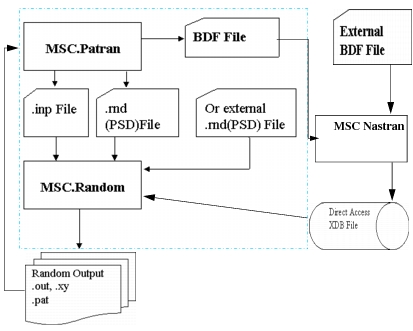XXXXXXXXXXXXXXXXXXXXXXXXXXXXXXXXXXXXXXXXXXXXXXXXXXXXXXXXXXXXXXXXXXXXXXXXXXXXXXXXXXXXXXXXXXXXXXXXXXXXXXXXXXXXXXXXXXXXXXXXXXXXXXXXXXXXXXXXXXXXXXXXXXXXXXXX''"> 11.1 Introduction
Purpose
MSC Random is a random analysis software package for use with MSC Nastran and Patran. It was developed by field engineers at MSC to offer a fast integrated random analysis solution from within the Patran environment. All of MSC Random’s analysis capabilities and generated results are available from within the PATRAN environment.
MSC Random software technology is similar to the existing MSC Nastran random analysis capability. In both packages, random analysis is treated as a data reduction procedure that is applied to frequency response analysis, but MSC Random offers additional capabilities and graphical interface.
The program uses the MSC Nastran XDB file from MSC Nastran frequency response analysis to calculate the random responses. It calculates displacements, velocities, accelerations, SPCForce and MPCForce for grids and stresses, forces and strains for elements as requested in the MSC Nastran case control data section in the frequency response run. The program also creates a result file containing RMS responses that will be automatically be imported into Patran for creating fringe plots of RMS response. A xy plot of PSDF response, cumulative RMS, cross PSDF, relative PSDF or auto/cross correlation can also be created from within Patran.
MSC Random is also designed to make it easier for engineers familiar with MSC Nastran’s random analysis capability to adapt quickly to this new procedure. MSC Random requires the same initial frequency response run setup and the same random input format.
Features of MSC Random
Random response calculated for all output quantities saved using standard MSC Nastran output requests, such as stress(bilin,plot) = all, acceleration(plot) = all.
Once an MSC Nastran XDB result database is created then multiple MSC Random jobs can be run without rerunning MSC Nastran unless changes are made in FEM, boundary conditions, damping, or output frequency list.
MSC Random uses existing MSC Nastran Random Input(RANDPS, TABRND1) format described in MSC Nastran Quick Reference Guide (Ref 6).
The random input profile at intermediate frequencies is determined using either logarithmic or linear interpolation.
The RMS response and number of positive crossings are calculated using either logarithmic or linear integration.
For most common problems, frequency response analysis can be set up entirely within MSC Random interface. This includes support for all of the FREQi entries, damping table support and output requests.
Complete Patran interface for pre and post processing of random analysis from within Patran.
Advantage over Utility version of MSC Random
1. Allow xdb created by new BBBT(Blocked Binary Balanced Tree) method (MSC Nastran 2005+). This method supports creation of almost unlimited size of xdb. This feature can be activated by using Nastran System entry;
Nastran Dbcfact = 4 (See example 2)
2. Support new SPCD method for enforced motion (See example 1).
3. Support both Real/Imaginary and Magnitude/Phase output in Frequency Response analysis.
4. Support for large number of Random Input profile (Number of Randps entries 250,000)
5. Log and Linear Integration.
6. XY Plot:
Von-Mises Stress plot for solid and plate, at center and corners.
Support for Cross Spectral Density and Cross-Correlation.
Relative Response (Calculation on fly without using MPC).
7. RMS Fringe Plots
Von-Mises Fringe Plots – solid and plate at center and corners.
Log-Log or Linear Integration.
Scale Factor for fringe plots (e.g. 3 * RMS)
Import results as scalar rather than tensor to prevent improper use.
8. Von-Mises stresses are calculated based on well accepted method outlined in publication (see Ref 3, 4).
Architecture of MSC Random
MSC Random is organized into three distinct analysis processes;
1. Frequency Response Analysis: The frequency response analysis must be performed first and transfer function results are saved on direct access xdb file. This can be setup from within MSC Random or Patran core interface. The xdb file can also be created by running existing Nastran input file in batch mode. Results from both method, Modal Frequency Response (sol 111) and Direct Frequency Response (sol 108), are supported.
2. Random Response XYPlots: XDB file, created by frequency response analysis, must be selected and then select PSD (Power Spectral Density) input profile. Several random output quantities, such as grid response (relative displacement, acceleration, velocity, SPCForce, MPCForce) and element response such as stresses, strains, forces are available for xyplot.
3. RMS Fringe Plots: RMS Fringe plots of grid responses (displacement, velocity, acceleration) and element responses (stress, strain, forces) can be created after selecting xdb file and random input profile.
Fig 1-1 illustrates how MSC Nastran, Patran and MSC Random work together.
MSC Random Interface
Figure 11‑1 MSC Random Flow Chart
Limitations
1. Maximum number of output frequencies: 32,768.
2. Maximum Number of RANDPS entries: 250,000.
3. Maximum Number of TABRND1 entries: 250,000.
4. MSC Nastran elements supported CBAR, CBEAM, CROD, CONROD, CTUBE, CBEND, CDAMP, CBUSH, CELAS, CQUAD4*, CQUAD8*, CQUADR*, CTRIA3*, CTRIA6*, CTRIAR*, CSHEAR, CHEXA*, CPENTA*, CTETRA*.
* Centroidal and Corner Forces, Stresses and Strains

